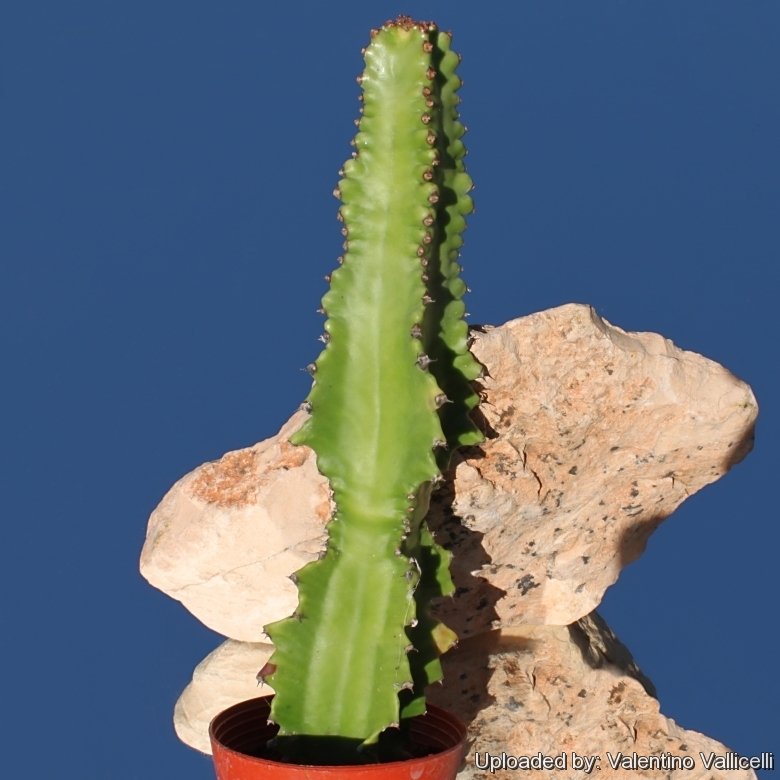
Euphorbia erythraeae f. monstruosa Photo by: Valentino Vallicelli
Origin and Habitat: Garden origin (Nursery produced cultivar)
Synonyms:
See all synonyms of Euphorbia erythraeae
Description: Euphorbia erythraeaeSN|13395]]SN|13395]] is one of the innumerable local form of the very variable Euphorbia abyssinicaSN|1958]]SN|1958]]. It is a nice large, cactus-like, candlestick, arborescent or arboreal Euphorbia with short thorns. In cultivation there are several monstrous clones all named Euphorbia erythraeaeSN|13395]]SN|13395]] f. monstruosa with stems of different shapes and sizes (usually smaller), so making a precise descriptions may be difficult. Some clones are only slightly monstrous and differ minimally from the standard species while other clones differs conspicuously.
Stems: More or less, columnar, angular, 4-8 cm wide, irregularly constricted into ovate segment approx 15 cm long.
Ribs: Usually 4 (but up to 8) very deep, vertical or slightly twisted with thin walls and shallow sinuate teeth up to 12 mm apart.
Spines: Spine Shields triangular, about 10 x 7 mm wide, separate or closely packed (almost touching) on the rib border, becoming corky. Spines in pairs, stout 2-10 mm long.
Leaves: Ovate lanceolate, 2-5 cm long only on new growth at stems tips.
Flowers: Cymes, simple 1 to 5 together. Cyathia 8-12 mm wide, peduncles up to 5 mm long stout, nectar glands elliptic yellow, almost touching.
Fruits: Capsules about 12 x 15(-25) mm wide, subglobose, fleshy, white turning red, hardening brown, becoming deeply 3-lobed at maturity before dehiscence.
Seeds: Smooth, subglobose, 4,5 x 3,5 mm wide.
Subspecies, varieties, forms and cultivars of plants belonging to the Euphorbia abyssinica group
 Euphorbia erythraeae f. monstruosa Photo by: Valentino Vallicelli
Euphorbia erythraeae f. monstruosa Photo by: Valentino Vallicelli Euphorbia erythraeae f. monstruosa Photo by: Valentino Vallicelli
Euphorbia erythraeae f. monstruosa Photo by: Valentino Vallicelli Euphorbia erythraeae f. monstruosa Photo by: Valentino Vallicelli
Euphorbia erythraeae f. monstruosa Photo by: Valentino VallicelliSend a photo of this plant.The gallery now contains thousands of pictures, however it is possible to do even more. We are, of course, seeking photos of species not yet shown in the gallery but not only that, we are also looking for better pictures than those already present.
Read More... Cultivation and Propagation: It is an easy species to grow that is suited for any well drained soil in full sun. But young plant are happy growing indoors, where they can easily reach the ceiling.
Growing rate: It is a moderately fast grower, but definitively slower growing than the standard species.
Soil and pots: Give the plant an airy growing medium which mainly consists of non organic material such us clay, pumice, lava grit, and only a little peat or leaf-mould. If plant becomes very red, this is a sign that the roots have not developed properly, so repot the plant with fresh growing medium. Like quite small pots, repott in very later winter, early spring. It will be content in its position and with its soil for years.
Watering: Water regularly during the active growing season from March to September. No water should ever be allowed to stand around the roots. Keep almost completely dry in winter.
Fertilization: Need a perfect fertilizer diet in summer. Use preferably a cacti and succulents fertilizer with high potassium content including all micro nutrients and trace elements or slow release fertilizer.
Wing tolerance: Only downside is from strong winds, the columns often smash into each other, causing permanent scarring... best to plant in such a location where winds are not a big issue.
Exposure: It can tolerate moderate shade, and a plant that has been growing in shade should be slowly hardened off before placing it in full sun as the plant will be severely scorched if moved too suddenly from shade into sun.
Maintenance: Can be pruned for shape and branching.
Hardiness: Frost tender, frost free zones only.
Warning: All Euphorbias contain a white sap that can be irritating to eyes and mucous membranes. If contact is made with this white sap, take care to not touch face or eyes before washing hands with soap and water.
Propagation: It is easy to propagate by cuttings in late spring to summer, just take a cutting of the plant let it dry for 1 or 2 weeks and stuff it in the ground (preferably dry, loose, extremely well draining soil). It is better to wash the cut to remove the latex. Place the cutting in a warm, bright and slightly humid spot, to increase the building of new roots.













